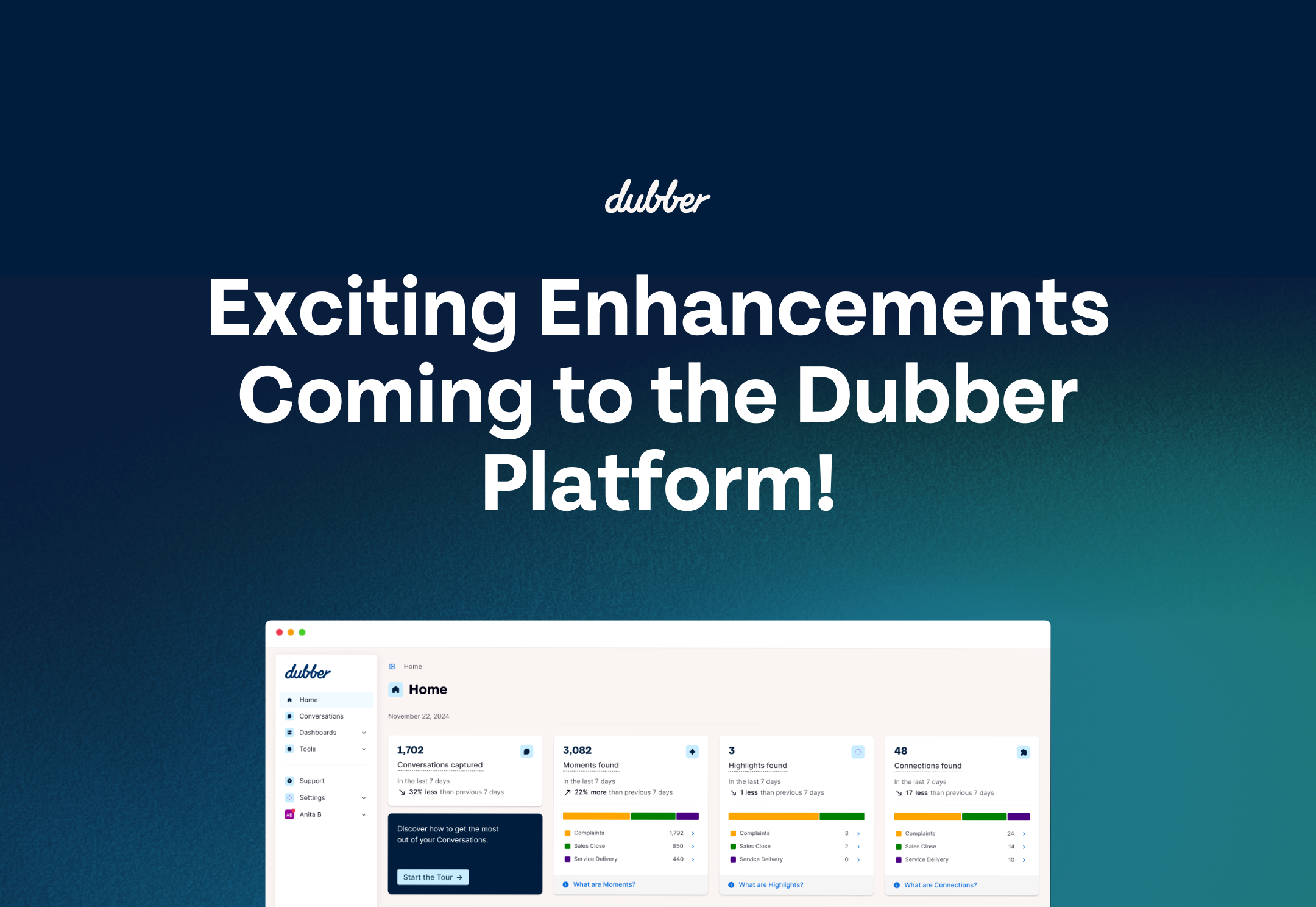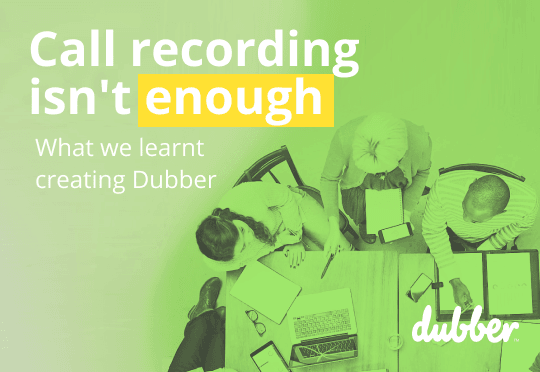
The twenty features you need to ensure your call recording solution meets your compliance needs.
1.Are your recordings clear and accurate?
Recording for compliance is all about accurate record keeping. If all you’re recording is background noise, or broken speech from a poor connection, you’re not really fulfilling your compliance requirements. Your call recording solution should record directly from the network to make sure that every word is crystal clear, no matter the quality of the call.
2.Is your storage secure enough?
When it comes to compliance, particularly in the financial services industry, you’ve got to be in it for the long-haul. Regulations such as MiFID II can require companies to store their recorded conversations for up to 7 years, or even longer. Your call recording solution must have the storage capacity to securely store recorded calls long-term. Cloud storage has a significant advantage over on-premise storage here, as there are no worries about ever running out of space.
3.Can your call recording solution scale to meet demand?
Speaking of storage and capacity…to make sure you capture every single conversation, your call recording solution will need to be scalable enough to cope with multiple concurrent recordings. If you’re running a huge global organisation, there could be hundred or even thousands of conversations happening at once. You need to ensure that all of these calls are recorded.
4.Are your recordings encrypted?
Captured calls need to be protected. With conversations containing highly sensitive personal data, these recordings must be encrypted. And we don’t just mean in storage. Data should be encrypted in transit with transport layer security, as well as at rest. AES-256 is one of the strongest block ciphers available – we encrypt every protected object with a unique encryption key. The object key itself is then encrypted with a regularly rotated master key, for that extra layer of protection.
5.Are you able to record every single call?
We’ve never navigated as many communication channels as we do today. Whether taking client calls on your mobile while we work from home, or chatting with colleagues over Microsoft Teams, for regulatory compliance you need a Unified Call Recording solution that can capture calls across every device and channel.
6.Is your data protected by geographic redundancy?
To really ensure stored data is fully protected, there should be redundancy measures in place to mitigate risk. On-premise solutions can’t compete with the ability of cloud platforms to deploy across multiple data centres within a geographic region. Platform loads can be spread across data centres to provide full redundancy across all elements, including storage.
7.Is your solution available, even in unprecedented events?
Another area that cloud solutions excel in is availability. The various elements of cloud platforms can be decoupled and run as separate services, while processing can be swapped to different servers without downtime. Cloud platforms deploy load balancers to manage traffic and scale processes. Data centre connectivity can be managed and, in the event of catastrophic failure, moved accordingly across the platform architecture.
8.Is all of your data held in one place?
Having data stored in multiple locations is a compliance nightmare. In order to reduce the complexity of compliance, all of your organisation’s recorded conversations should be stored in one unified repository.
9.Do you have a retention policy in place?
Deleting data once it’s no longer required is as equally important as storing it securely in the first place. Particularly when it comes to compliance with regulations like the GDPR, it’s vital that organisations erase data when they no longer have a legitimate purpose to store it. Your call recording for compliance solution should include the option to set retention periods for recordings so they are automatically deleted after a specified period.
10.Are you prepared for a legal hold request?
Legal hold requests can happen at any time. These events mandate the preservation of information, including recorded calls, and can cause hassle for businesses if their data isn’t stored in a unified repository. To cover legal hold requests, your call recording solution needs to have a feature to preserve recorded calls no matter what. This should override standard retention periods, the deletion of a user or the expiration of overall storage periods.
11.Who can access recordings?
Access to recorded calls should be restricted to appropriate users for data protection, so your call recording solution should enable strict and secure permissions and team structures. Make sure you can group users into teams and control who can listen to recordings within a team. As standard, users should only be able to listen to their own recordings and users outside a team shouldn’t be able to access recordings.
12.How is access to recordings authenticated?
To ensure data is transmitted securely, access to recorded calls should be monitored and your call recording solution should employ stringent password policies and granular permissions that control user access to system features, functionality, and recorded data. For extra security, access to content should be via tokenised sessions.
13.Can you instantly retrieve recordings?
Often regulatory compliance requires instant access to data in order to comply with audits or other requests for information. All recorded calls should be instantly available to prepare for these kinds of situations. Cloud solutions are the ultimate solution – with recorded call data immediately available to replay, securely download, review, or delete on request.
14.Are your recordings time-stamped?
As part of regulatory audits, legal hold requests, or dispute resolution, organisations are often required to retrieve all calls from a specific time or date. Your recording solution should time-stamp all calls and allow search results to be filtered by date or time as well as user.
15.Can you pause and resume recording for PCI DSS?
Any organisations that take card payments over the phone will be familiar with the requirements of PCI DSS compliance. Certain payment card information is not allowed to be collected so your call recording solution must have the ability to pause and resume recording.
16.Does your call recording solution proactively mitigate risk?
Most industry regulations have been put into place in order to protect consumers and promote best practices. Your call recording solution can actually be a useful tool for proactive improvements and risk mitigation when it includes voice AI. When calls are transcribed, keyword searches can be put in place for the early detection of risky behaviour – deterring potential bad actors.
17.Can you securely export your data for visualisation?
Exporting voice data, securely of course, for analysis is another way to get a really clear picture of how your organisation is operating in order to reduce your level of risk. By visualising trends across a company, business leaders can get clear visibility over their operations.
18.Do you receive alerts for risky behaviour?
In order to respond to compliance risks instantly, you need real-time alerts to risky behaviour within your organisation. Using transcription, your call recording solution should provide the ability to create instant alerts for keywords specific to your industry or even your organisation. When these words are spoken during a call, managers or supervisors will receive an email warning them and giving them a link to the recording of the conversation in question.
19.Can you implement intuitive workflows and rule-based automation?
Automation shouldn’t stop at keyword alerts. To streamline processes within a business, your call recording solution should include an open API that allows you to create intuitive workflows and rule-based automation. These can automatically populate other business applications with call data for increased productivity and visibility across operations.
20.Can you ensure business continuity?
Business continuity really came to the forefront in 2020 and is a key component of any organisation’s risk and compliance management. Ensuring that your business can continue to operate securely, no matter where your workforce is based is essential. With remote working looking increasingly like it is here to stay, your call recording solution must not be confined to your office. Likewise with data storage. Ensure your voice data is protected by storage that will continue to operate securely, even in the face of unprecedented events.
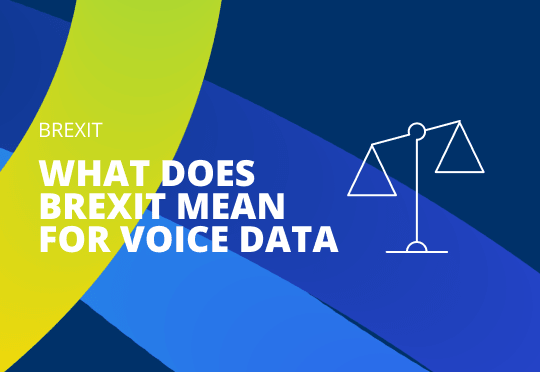
It’s official, the UK is no longer part of the European Union and the transition period is rapidly coming to a close. What does this mean for data protection? Do businesses still need to comply with the GDPR after December 31st 2020?
For those businesses who operate within the European Economic Area (EEA) and record their phone calls, they must check that their protection of voice data is sufficient for a post-Brexit world. If data is processed in the UK, they must ensure that they have contractual provisions in place to reflect any flow of data between the EEA and the UK. Any preparations need to consider the progress of negotiations that are continuing during this current transition period. GDPR may well remain part of UK law.
What legislation currently applies?
Parliament has passed The Data Protection, Privacy and Electronic Communications (Amendments etc) (EU Exit) Regulations 2019, which is basically the GDPR but applicable to a UK-only context. This will apply from the end of the transition period. If you’re a business based outside of the UK and offer goods or services to or monitor individuals in the UK this is applicable to you. If you’re a UK business and you’re already compliant with GDPR, and you don’t have any customers or contacts in the EEA, then you’re already sorted…or are you?
Any data protection plans are contingent on an adequacy decision from the European Commission, where the European Commission decides whether the UK offers an adequate level of data protection. With a rewrite of UK data protection laws potentially on the horizon, an adequacy decision could be significantly delayed. If no adequacy decision is made, businesses may need to amend their current contracts in order to continue data transfers. The extra cost of this undertaking could be bad news for small businesses.
What happens after the transition period?
From January 1st 2021, the UK will be deemed a “third country” under the GDPR, which means personal data from the EEA will only be able to be transferred if:
- The European Commission issues an adequacy decision
- Appropriate safeguards are in place
- There is an agreement of approved codes of conduct
- There is certification under an approved certification mechanism together with binding and enforceable commitments on the receiver outside the EEA
If you’re a UK business that receives personal data from contacts in the EEA, you will need to take extra steps to ensure that this data transfer can still go ahead. If you’re a UK business with some form of presence or customers in the EEA, you’ll have to comply with both the UK and EU legislation and may even have to appoint a European Representative. You will need to implement an appropriate mechanism to transfer personal data from the EEA to the UK and any onward transfers to another third country. Several of these mechanisms are already laid out in the GDPR, including standard contractual clauses adopted by the European Commission (SCCs).
Organisations should be able to continue transferring data from the UK to the EEA, but data protection documentation and contracts will require updating.
Businesses that transfer data from the UK to countries outside the EEA should be able to continue with existing processes for now, but any reforms of UK data protection laws could change that. The really tricky part is transferring to and from the US. This is due to the EU/US ‘Privacy Shield’ agreement being declared invalid by the EU Courts. This means yet more contract updates and appropriate safeguards.
What is Dubber doing to prepare for Brexit?
Dubber already complies with GDPR and will ensure that we continue to do so after the transition period, whether or not the UK is considered an adequate third country.
Let us know if you have any questions about voice data and Brexit.

As business becomes more and more international, the languages used to communicate only become more numerous. This globalised way of operating requires a multilingual approach.
With national economies fluctuating constantly, the dominant languages of business may change – and global companies will need to be prepared. As part of their international expansion, businesses should include language in their strategy.
In the same way that machine translation has improved accessibility online, machine transcription is facilitating global business. The intersection of machine learning and language translation is helping businesses across the world reach new audiences. Part of Dubber’s mission to bring voice AI to everybody is breaking down language barriers and allowing everyone to operate in their preferred language. Offering more languages for transcription helps us better serve businesses who operate globally.Good communication allows people located across the globe to exchange information and ideas and coordinate work and business operations. With remote work the new normal, business in the future may operate from different continents as standard. AI is facilitating this. Research in the US found that the introduction of machine translation increased exports by 10.9% and improved economic efficiency1.
Speaking your language
Not only is it important that your voice transcription solution supports different languages but also regional variants. While Spanish speakers from around the world might speak the same language on paper, there are many regional differences. Companies who operate in Spanish speaking areas including Puerto Rico and Mexico use Dubber’s services, and are supported by the regional transcription variants that we provide.
In order to offer the broadest possible range of languages to our customer base we use multiple transcription services – adding Google Cloud Speech-to-Text to our arsenal this year. Google and IBM Watson also help us to identify caller sentiment, including tone and emotion.
One of the key advantages of AI transcription is speed: AI can transcribe hours of recordings quickly – work that would take human transcribers days or even years. This makes machine transcription much cheaper than employing a human transcriber, or using the time of your staff to review calls. With voice AI able to detect keywords and analyse the sentiment of a call, the expertise of your employees can be saved for reviewing the tiny sample of calls identified as requiring attention.
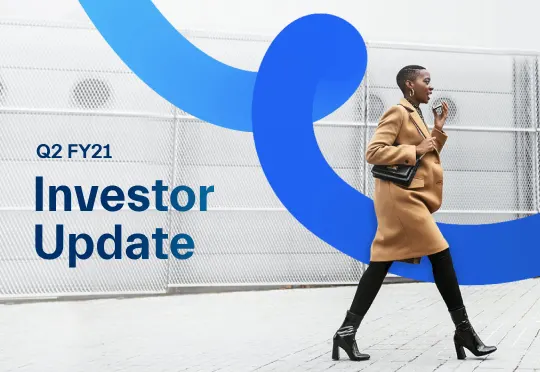
Today we had the opportunity to take Shareholders through Dubber’s strategy and why we are so excited about the opportunity ahead of us.

James Slaney is the co-founder of Dubber. Here he gives us an overview of how voice data can provide solutions to business problems.
There’s one piece missing from every organisation’s compliance and performance puzzle. Voice. And AI powered Unified Call Recording is the answer.
Today the majority of our business interactions are voice-based. And more than ever, those calls are happening outside of the call centre.
When those calls and conversations end, critical content and value is lost forever. Imagine losing the majority of your data every day.
Traditional approaches to call recording don’t work when calls are happening across devices and communication platforms like Microsoft Teams. Hardware costs, lack of scalability, insurmountable technical barriers, and compliance difficulties mean a new approach is needed.
Businesses are left not knowing.
With customers consistently choosing to contact brands over the phone, critical content and value is being lost every day. Businesses who aren’t capturing their voice data are left asking what their customers are saying, whether they’re satisfied, what the details of their orders were, and whether their records are up to date.
That’s why we created Dubber, the world’s #1 Unified Call Recording solution powered by the cloud and AI. It’s the only fully scalable and compliant solution that can be switched on with a click.
A data-driven approach to customer and employee experience is critical to the growth and development of an organisation, particularly In today’s hyper-competitive economy.
Unified Call Recording automatically captures every call and transforms conversations into tangible data through AI. Voice data can be used to power transcripts, real-time search, alerts, and sentiment analysis.
Only 36% of executives have real-time, highly integrated capabilities across all customer channels within their enterprise.
Data doesn’t stop with Dubber. The future of customer service will see one unified record of interactions across every channel, no longer requiring a customer to relay their entire history to each new representative they speak to. Why wait for the future? What if every customer call was automatically transcribed and logged within your company’s CRM application?
Using an open API, businesses can populate CRM tools with a unified record of customer interactions. Imagine every Salesforce record up-to-date with the most recent customer conversation: including the recording, transcript, and even customer sentiment.
The integration of business data is the foundation for superior data-driven customer experiences and compliance.
Together we can unlock the potential of voice data to power better business outcomes, enterprise transformation and business continuity.

If you’ve ever dealt with a legal hold request, you’ll know how difficult this mandated preservation of information can be to manage. But there is a solution that can reduce the cost and complexity of complying with a legal hold request.
What is a legal hold request?
A legal hold (or litigation hold) request is when legal counsel asks an organisation to preserve information that could be relevant to litigation, an audit, or investigation: including electronic records such as emails, instant messages, and voice recordings.
A company may have multiple active litigation cases – each with its own legal hold requirements. Legal holds cover anyone who might possess relevant information, called custodians. The list of custodians may change throughout the process so companies need an agile solution that can quickly and easily place new information under legal hold.
For companies with information in multiple locations such as employee devices, on-premise servers, and data centres: beware. This distribution of data could cause your risk and compliance teams a headache. Having one centralised location for records makes identifying information and placing it under legal hold much easier.
Dubber’s Legal Hold feature
Businesses can prepare for external events that might impact their business. These might include a simple late payment issue with a customer, litigation, regulatory audit, or even government investigation.
To rest assured that any voice recordings and their associated data can be held for investigation quickly, easily, and effectively, all CALL DUB and DUB AI licences now include our new Legal Hold functionality as standard. This vital compliance feature is included at no extra cost to provide reassurance that recordings can be preserved should the need arise.
How does it work?
Dubber’s Legal Hold functionality allows users to tag single or multiple recordings as held. Selecting multiple recordings at once assists organisations in complying with a legal hold request and preserving large quantities of information at short notice.
Once a recording is tagged as held it can be played, downloaded, and shared as with any other recording – but cannot be deleted under any circumstances. Held recordings are protected from erasure even when the retention period for the recording expires, if the user associated with the recording is deleted, or the overall storage period expires.
Dubber users can already store and manage all of their recorded voice data securely and efficiently in one single, consolidated archive within the cloud platform. With unified record keeping and automated retention periods, compliance procedures are streamlined and these now include legal hold requests.
Legal Hold allows users to target specific recordings for analysis without the need for technical assistance or expertise. Recordings can be tagged as held in bulk by filtering recordings by customer, keyword, or user. Only users with admin permissions can tag recordings as held, standard users are unable to use the feature or use filters to locate held recordings.

Customer experience starts and ends with customer satisfaction. But how do you know when a customer is satisfied or not?
Enterprises today measure customer satisfaction through a combination of anecdotal evidence and often slow reporting. Most see a significant gap between industry leaders and their peers. Leaders are moving to real-time and predictive views of customer experience.
And that’s where Unified Call Recording comes in.
A recent Walker Info report revealed that customer experience is overtaking price and product as a key brand differentiator. The report further shows that 86% of buyers are willing to pay more for a better customer experience.
At the core of these efforts is capturing every conversation with a customer in real-time, using AI to score the conversation sentiment, and presenting data in real-time – not just in dashboards but in every customer record.
This same data becomes the fuel for “Know Your Customer” – a key component of most global compliance mandates.
A Forbes Insights survey of 357 executives found that the benefits of data-driven customer experience are wide-ranging – including enhancing revenue generation and enabling cost reduction, as well as process efficiencies and quality improvements.
Unlocking happiness
The point of sentiment analysis isn’t just to know what was said, but to be able to do something about it. Modern Unified Call Recording platforms don’t just tell you how satisfied your customer is, they tell you how satisfied your employees are. Integrating employee experience is essential to improving customer satisfaction. Effective use of Unified Call Recording will tell you the real impact.
Recorded calls are an invaluable resource for training and quality control. Don’t throw your new staff into the deep end – show them what works well and what doesn’t during their onboarding by playing them real calls.
But don’t just take it from us, let one of our customers show you how they’re using voice data to optimise their customer experience.
A&E Auto Glass on Dubber
“The Dubber solution has been a great blessing for our company because we are able to listen to calls for quality and training purposes.”Eric Solheim, A&E Auto Glass
A&E Auto Glass are a family-owned business that has been working to provide the best windshield replacement experience for 17 years. We spoke to owner Eric Solheim about how A&E Auto Glass are improving customer experience with Dubber.
Dubber: What was the challenge that brought you to choosing Dubber?
Eric Solheim: We didn’t have call recording and wanted an affordable solution to help with dispute resolution, as well as to enhance our employee training. Our ultimate goal was ensuring customer happiness and accuracy in our communications.
D: How did Dubber help you solve this problem?
ES: Since deploying Dubber, dispute resolution has vastly improved with accurate records of conversations with customers. We know exactly what was said, which protects us against any future liability. We also use recorded calls to enhance our staff training to ensure that our customers are getting the best service with accurate information.
- 50% increase in disputes resolved in favour of the company
- 70 phones at the company
- 98% accuracy of recorded calls
D: What was the process of going live with Dubber like?
ES: We have our telephony service with Cox so Dubber was a clear choice as it’s the best deal out there with our phone system. They aren’t just the best deal though; their solution works very well and we deployed it across all 70 phones in our business.
The results have been great, 98% of the time the call is perfect quality. The Dubber solution has been a great blessing for our company because we are able to listen to calls for quality and training purposes. Not only is the price reasonable, but the customer service is very helpful and quick to respond. I would definitely recommend Dubber!
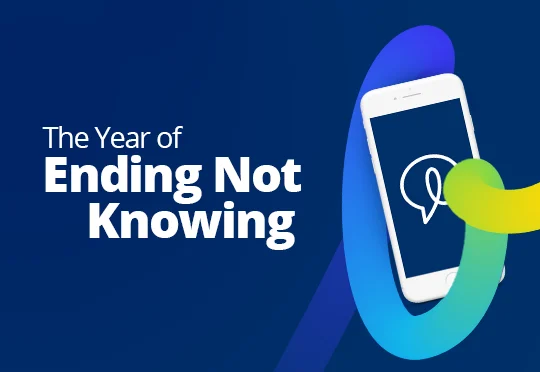
End the productivity and visibility trap
Unified Call Recording can capture customer calls and automatically log them within a CRM such as Salesforce. But to earn some serious points with your sales team, give them the gift of voice AI. This can act as a personal assistant to your sales reps: transcribing their calls so they never have to take notes ever again.
Recordings and transcripts can be used to inform lead prioritisation, the coaching of team members, and much more.
According to research by Salesforce, 67% of sales people say that enforcement of activity logging is stricter than in 2019, and 63% of reps log more details about customer interactions than they did in 2019. The reality is most sales leaders bemoan the fact that Salesforce isn’t up to date or current. What if you could automate this logging for your sales team and get them back to selling?
For most sales teams this can equate to another day of selling every week. Another day!
End not knowing
Ever wondered what was said? How the customer was really reacting?
Rather than hearsay, how about letting AI tell you.
With sentiment analysis, positive and negative conversations can be identified to coach new and existing team members, create alerts for negative calls, and track campaigns, competitors, or trends in customer enquiries.
Sales teams need to understand the needs of their customers and build trust through listening. But are they being supported by business tools, or being let down by them?
“Sales leaders today are plagued by not knowing and no one likes surprises – particularly at the end of the month or quarter. Customer experience is equally impacted as salespeople transfer what was heard into manual notes and back into CRM platforms. Unified Call Recording accelerates sales momentum – giving back valuable selling time to reps and, critically, ending not knowing. Implementing Unified Call Recording should be a priority for every sales leader.”Russell Evans, CRO, Dubber
Bring it all together
Unified Call Recording enables it all to come together. Every conversation captured from any end-point. No salesperson works on any one device or platform. We jump between Webex, Teams, mobile, and more. So record and capture every conversation and, with them all in one place, seamlessly integrate with Salesforce and your preferred data visualisation dashboard for real-time record keeping and insights. Set alerts on keywords and more.
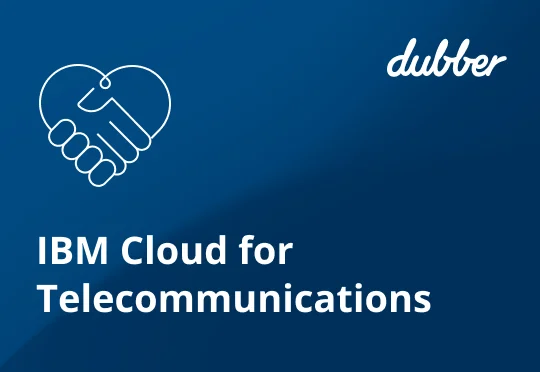
Dubber UCR & Voice Intelligence Cloud will help clients unlock benefits of IBM’s open and unified hybrid cloud architecture, built for the telco industry and delivering security, AI-driven automation and end-to-end service orchestration.
Melbourne, Australia – Dubber Corporation Limited (ASX: DUB) (Dubber) today announced it has committed to join IBM’s (NYSE: IBM) ecosystem of partners supporting the new IBM Cloud for Telecommunications. The IBM Cloud for Telecommunications is an open, hybrid cloud architecture designed to accelerate business transformation with the power of edge and 5G and address the unique requirements of operators, partner ecosystems and their enterprise clients. Built on IBM Cloud Satellite, currently in beta, and leveraging Red Hat OpenShift, clients can deploy cloud services anywhere: on the cloud, on premises or at the edge, while addressing industry-specific regulatory and security requirements.
Dubber’s Voice Intelligence Cloud will help Service Providers deliver next-generation Unified Call Recording and Voice AI Services on a unified cloud platform. Its Unified Call Recording™ (UCR) solution will integrate and be interoperable with IBM Cloud for Telecommunications and is designed to enable Service Providers to offer solutions critical to their customers addressing compliance mandates, improving sales and service performance and unlocking the possibilities contained within voice data.
“In simple terms, by leveraging IBM Cloud for Telecommunications, Dubber can help enable service providers to differentiate and create value from the conversations occurring on the network by making call recording and voice data as a service (VdaaS) ubiquitous and open,” said James Slaney, co-founder, Dubber. “All conversations can be captured in the Cloud and converted to AI-enriched data. Dubber will make it easy to capture calls – from traditional landlines to 5G services, and end-points provisioned by the Service Provider.”
“We are excited to collaborate with Dubber as part of the IBM Cloud for Telecommunications Ecosystem, to offer telecom operators access to the best technology that can help them scale and innovate.” said Evaristus Mainsah, General Manager, Cloud, Cloud Pak and Edge Ecosystem, IBM. “The power of IBM’s Ecosystem provides clients a wide range of ways to leverage the platform, positioning them to deliver next generation 5G and Edge services; deploy and manage new cloud capabilities; and enrich relationships through AI-driven engagement.”
The IBM Cloud for Telecommunications is engineered to integrate advanced AI and automation processes at the edge and speed services deployment while simultaneously reducing overall costs. With an open, container-based architecture managed as a service, operators and their providers will be able to easily integrate, automate and orchestrate how they run network and IT workloads across any environment. The platform leverages IBM’s industry-leading encryption capabilities like Keep Your Own Key (KYOK), giving clients full control of their data.
Dubber has committed to join the IBM Cloud for Telecommunications Ecosystem, an initiative to help network equipment providers, independent software vendors (ISVs), software-as-a-service providers, and hardware partners accelerate business transformation by unlocking the power of 5G and edge. The IBM Cloud for Telecommunications is an open, hybrid cloud architecture built on IBM Cloud Satellite, currently in beta, and leverages Red Hat OpenShift to enable clients to deploy IBM Cloud services anywhere: on the cloud, on premises or at the edge, while addressing industry-specific regulatory and security requirements. Red Hat OpenShift is the industry’s leading enterprise Kubernetes platform.
For more information, please contact:
Investors
Simon Hinsleysimon.hinsley@dubber.net
+61 (0) 401 809 653
Media
Terry Albersteinterry@navigatecommunication.com.au
+61 (0) 458 484 921

Dubber “Best of Breed” UCR & Voice Intelligence Cloud selected for IBM Cloud for Telecommunications Services

